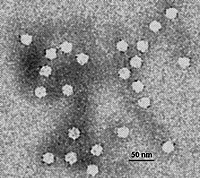
Photo from wikipedia
BACKGROUND Brugada syndrome (BrS) is a primary arrhythmia syndrome affecting 1 in 2000 of the general population. Genetic testing identifies pathogenic variants in the sodium voltage-gated channel α-subunit 5 gene… Click to show full abstract
BACKGROUND Brugada syndrome (BrS) is a primary arrhythmia syndrome affecting 1 in 2000 of the general population. Genetic testing identifies pathogenic variants in the sodium voltage-gated channel α-subunit 5 gene (SCN5A) in up to 25% of familial BrS. Balanced translocations, which involve the exchange of the ends of 2 different chromosomes, are found in approximately 1 in 500 people. They usually are benign and only rarely are reported to cause arrhythmogenic disorders. OBJECTIVE The purpose of this study was to identify the genetic mechanism underlying a family with BrS, sick sinus syndrome, cardiac hypertrophy, sudden cardiac death, and multiple miscarriages. METHODS We clinically evaluated family members with an electrocardiogram, 2-dimensional echocardiogram, and provocation testing with ajmaline challenge. Cytogenetic testing included karyotype and fluorescent in situ hybridization (FISH) analysis. We performed gene panel, exome, and genome sequencing analysis. RESULTS Sequencing of 128 cardiac genes and exome sequencing of a family with BrS, sick sinus syndrome, cardiac hypertrophy, sudden cardiac death, and multiple miscarriages did not reveal a pathogenic variant. Karyotype and FISH analysis identified a balanced translocation breaking the SCN5A gene on chromosome 3 and the multiple chromosome maintenance 10 gene (MCM10) on chromosome 10 t(3;10)(p22.2;p13). We characterized both translocation breakpoint junctions using genome sequencing and found no regions of sequence homology. CONCLUSION A balanced translocation breaking SCN5A is a novel mechanism underlying disease in a family with BrS, sick sinus syndrome, cardiac hypertrophy, and sudden cardiac death. Genome sequencing can identify rare chromosomal aberrations causing inherited diseases that may otherwise be missed using gene panel and exome sequencing-based approaches.
Journal Title: Heart rhythm
Year Published: 2019
Link to full text (if available)
Share on Social Media: Sign Up to like & get
recommendations!